#Instagram data analysis
Explore tagged Tumblr posts
Text
#Instagram analytics#Instagram metrics#Instagram data analysis#Instagram insights#Social media performance tracking#Instagram engagement measurement#Instagram account statistics#Instagram growth analysis#Instagram marketing analytics
2 notes
·
View notes
Text

Sketched out the final part of the growth spurt comic!
Already made up my mind, but out of curiosity. What do you think: Who will end up being the shortest turtle? :)
#Saw comments about both of them sooo… I just have to do some data collection before the last part drops!#And then we can compare twitter tumblr and instagram#some fun data analysis!
10 notes
·
View notes
Text
instagram
0 notes
Text
looking at summer job/internship listings is so scary because yeah i could apply but who knows if im well enough to work during the summer ?? i suppose applying wont hurt but like if i get an internship and i cant do it i'd feel like shit letting ppl down, or i push myself beyond my limits and then end up being worse again when uni starts.
#chronic illness#theres always the option to do online teaching in my degree subjects but working with children is scary idk if i'd like that#its also hard to know if i'm qualified enough for some jobs#because they use scary words like research and data analysis like ?? i just want to design instagram posts pls??#idk#but the thing is all the good job listings (the ones i can ethically stomach) end in april so after that my options will be rea shit#theres some that are at my uni but they all go until the 1st semester ends so i'd have to do that while studying. which is not realistic
0 notes
Text
do I have any followers or mutuals that have completed their MA in a humanities field and feels comfortable discussing a variety of methodologies? i'm struggling a little to delineate a framework for my own thesis methodology and it'd be so nice to talk it out with someone and get some advice!
#let me know <3#i'll be reading a book on qualitative data analysis for the next couple of days to see if I can make some things a bit clearer for myself#but yeah!#initially what I'd want to do is analyze instagram interactions be they posts or comments (discourse analysis)#and also do either a questionnaire or a likert scale survey
1 note
·
View note
Text
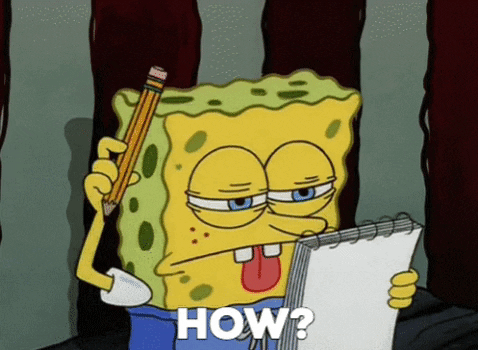
🌟 Thursday check in week 9 🌟
This 6-week content analysis assignment for #writ318mu has definitely intimidated me. I've hit a few roadblocks with this assignment. The work has included diligently tracking engagement metrics on Instagram from three cat influencers. Features including likes, comments, plays, and those irresistible captions. But now, I'm stuck on how to structure and make sense of this mountain of data. Maybe we’re facing similar issues. here are my pressing data analysis queries:
How can I effectively categorize and organize my Instagram data for insightful analysis?
And after getting the data organized, how would be the best way to insert the data in the 1st draft?
Are there specific data analysis techniques or tools that could unlock deeper insights from my Instagram treasure trove?
What are some tried-and-true methods for spotting trends and patterns in engagement metrics over the 5-week period I've been monitoring?
Your wisdom and guidance would be a game-changer in navigating this data labyrinth and acing my assignment. Feel free to share any insights, tips, or any helpful resources in the comments below! 📊💡
0 notes
Note
could you please do lando and a stem girl who goes to uni but has a private life please
they don't know about us | ln4 smau
pairing: lando norris x private fem computer science major!reader a/n: this took me forever but hope u still like :) also, if you've got requests could u add if you want it to be smau or fic pls <3

Instagram
landonorris posted to his story!
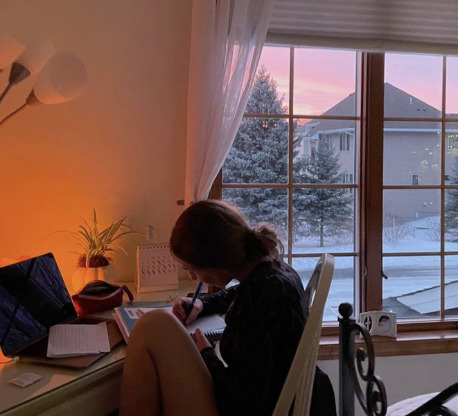
[ caption: Mind you, I just woke up... ]
[ tagged: yourusername ]
Twitter

Instagram
landonorris posted to his story!

[ caption 1: 🕒✈️ ] [ caption 2: miami 👋 ]
[ tagged: yourusername ]
yourusername posted to her story!
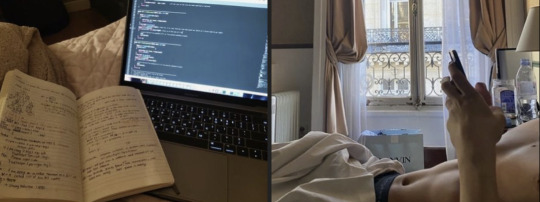
[ caption 1: shoutout to the inventor of coffee i owe u big time🙏 ] [ caption 2: uhm i was just going to rest my eyes for 2 minutes?? good morning i guess💀 ]
f1gossip
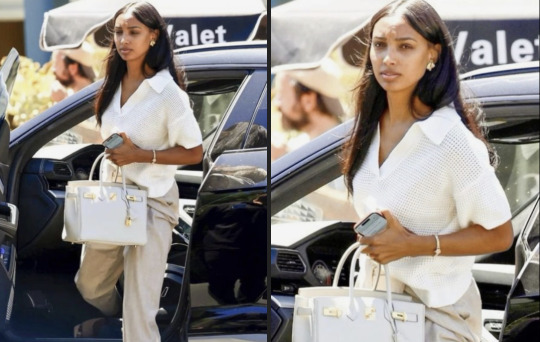
liked by username, username, username and 12,057 others
f1gossip Y/N L/N, current girlfriend of Lando Norris, has been photographed arriving at the paddock for today's Miami GP.
Y/N's presence comes as a bit of a surprise, considering she was absent during practice and qualifying sessions, and rarely attends races. Speculation about a potential breakup has been rampant, but her appearance suggests that there might not be trouble in paradise after all... 👀
view all 793 comments
username she always looks so classy and put-together, i'm obsessed <33
username no bc am i the only who has no problem with her only attending a few races a year? some ppl don't have time to jet off across the globe 24/7 like
username it's the fact that they literally travelled to miami together and she still didn't go to quali or practice😐 the other wags do it, why can't she?
username i just know lando had to beg her to come smh
username why are y'all so rude omg?? some ppl are introverts...
username when you're in the public eye, you don't get to be "introverted"🙃 username that's an insane take wtf?
username GUYS i think she's a uni student cause peep lando's story a few days ago🧐 that explains why she's never at gps
username so? i'm a senior and i went to the aus gp this year username okay... do you want a cookie ?
username if a wag is at all races she's fame-hungry, and if she doesn't she's unsupportive like make up y'all's minds pls 🙄
Twitter

Instagram
yourusername posted to her story!

[ caption: YOU DID IT!!! HE DID IT!!! MY BABY IS AN F1 WINNER OMFGGG🥹🥳👏 you deserved this so so much, i'm sooo proud of you ❤️❤️❤️ ]
[ tagged: landonorris ]
Twitter

Instagram
landonorris
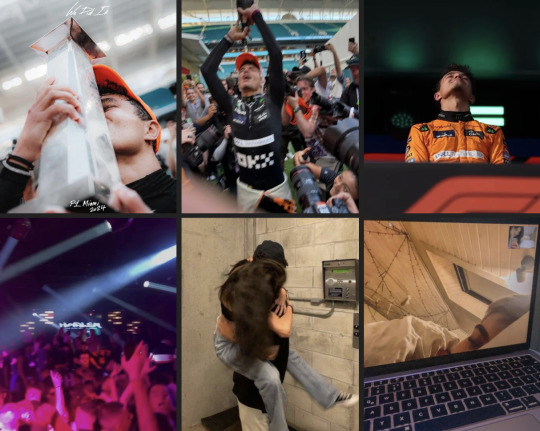
liked by yourusername, _aarava, martingarrix and 2,005,872 others
landonorris Memories for life ❤️
view all 5,947 comments
username aw the 5th pic🥹
username do you think number six is y/n??👀 username 100%
username 🧡🧡🧡🧡🧡
username LANDO NOW WINS IKTRRRRR‼️🤩
username ofc y/n couldn't even be bothered to comment... and the most unsupportive wag award goes to y/n l/n!! congrats hun x
username y'all are weird YOU DON'T KNOW THESE PPL!! username it's the 'be kind' in ur bio for me miss gurl 🤡
username best day ever 🤧
lewishamilton 👏👏👏
(liked by author)
riabish sooo happy!!!
(liked by author)
username not ria being more of a gf then y/n oop username thanks for being such a good friend to lando, we love you💖
username next goal: beome world champion 👀👀
username yessirrrr
yourusername posted to her story!
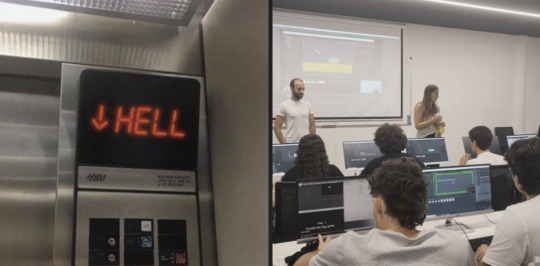
[ caption 1: back to reality 💔 ] [ caption 2: jkjk it's not that bad, i don't cry nearly as much as i did in first year 🙂↕️☝️ ]
[ tagged: yourbestfriend, yourfriend + more ]
harvard
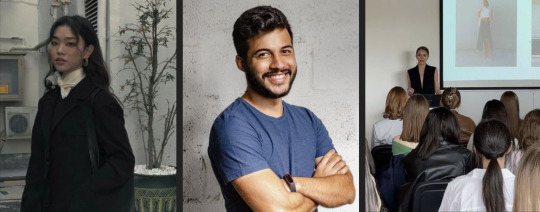
liked by yourusername, username, username and 29,063 others
harvard Final projects, theses, dissertations, and more! Check out what these soon-to-be graduates explored in some of their last assignements on campus.
Y/N's thesis navigated the intricate relationship between privacy and secure multi-party computation, enhancing data analysis while safeguarding sensitive information.
2. Steve's environmental science project examined urban development's impact on local biodiversity, providing insights for sustainable urban planning.
3. Nya's dentistry research poster explored new methods to improve dental implant success, promising better patient outcomes and oral healthcare.
—
We are celebrating the extraordinary members of the Class of #Harvard24 🎓
view all 127 comments
username 👏👏👏
username Awesome!
username Very good! Congrats to all these students!!💪
username wait am i tripping or is this y/n as in lando's gf y/n???😳 btw my biggest dream is to go to harvard in '26 !!!! 💕
username 😍😍
username streets are saying y/n goes to harvard so i had to come check and omg??😩
username no bc wag AND harvard girly?? just looked at myself and sighed fr... username now i feel bad for talking shit🫤
Twitter

Instagram
yourusername posted to her story!
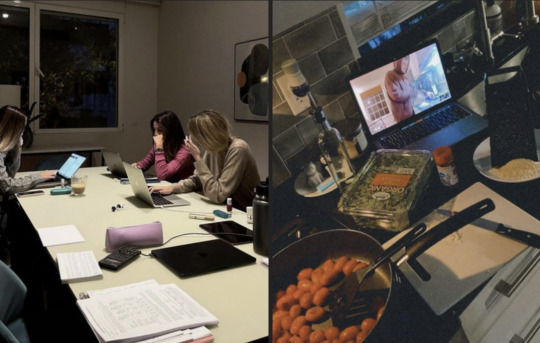
[ caption 1: pulling an all-nighterrrr 😁 ] [ caption 2: nevermind, lando just made me promise to get some sleep :( ]
A few months later...
Instagram
yourusername posted to her story!

[ caption 1: couldn't ask for better shoulders to cry on srsly 🙂↕️ WE DID IT MY LOVESSS 🎓❤️❤️ ] [ caption 2: this us? 😏 (corny, i know...) ]
[ tagged: yourbestfriend, yourfriend + more ]
lando.jpg
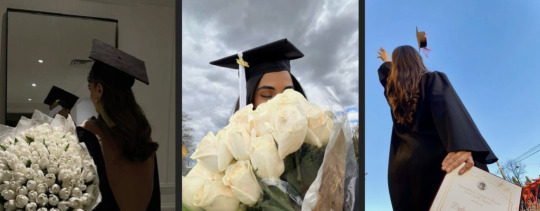
liked by daniel3.jpg, yourusername, carlossainz55 and 847,903 others
tagged: yourusername
lando.jpg 🍾🎓❤️
view all 4,037 comments
username a win for women iktr 😌
username wow i'm so happy for her omg 🫶🫶 (jealous too but mostly happy loolol)
username LMAO are we the same person?
carlossainz55 👏👏👏
username now she has no excuse anymore
username if lando's completely happy with it all, why the hell are u upset? 🤡
username 2024 really gave us lando's first ever win and now this?? we love to see it 😍
yourusername ❤️❤️
(liked by author)
username we love you y/n <333 username i hope you'll be able to attend more races from now on!! i love seeing you in the paddock 💕
username the way i still haven't fully processed the fact that harvard gave her a shoutout goddamn🤯
usernmae not you calling that a shoutout bye💀💀
username AAHHHH YAYY CONGRATS Y/N YOU'RE DOING AMAZING SWEETIE 🤍🤍🤍🤍
0:33 ───ㅇ───────── 2:40
#f1 smau#f1 fanfic#f1 x reader#lando norris#lando norris x reader#ln4#ln4 x reader#ln4 imagine#f1 imagine#ln4 x you#lando norris smau#lando norris x female reader#lando x y/n#lando x you#lando norris fanfic#smau#lando norris fluff#lando norris imagine#f1 instagram au#fanfic#f1 fic#lando x reader#ln4 fic#f1 scenario#formula 1 x reader#formula 1 fanfic#formula 1#lando norris one shot#formula 1 x you
2K notes
·
View notes
Text
Hey guys, quick PSA on Meta and them using your data for AI training:
Since April 7 this year they have a new privacy policy in place that, if you don't opt-out, will use your:
name
user name, profile picture, description
avatar
reels
photos and their descriptions
comments
from Instagram, your
name
user name, profile picture
avatar
posts
activity in public groups, channels, on public pages
comments
reviews and posts on Facebook marketplace
from Facebook, and your
profile picture, status
avatar
descriptions of groups / channels you created and joined
any conversations you held with Meta AI
any group chats you added Meta AI to
in WhatsApp to train their Meta AI models.
This change will start on May 27th, setting the deadline to the 26th to decline to their use of data.
How do you opt out? Meta provided two opt-out forms for that:
For Facebook, fill out this form,
For Instagram there is this one,
For WhatsApp, use this link and then pick the "Data Subject Rights Form" (translation may vary). Then pick the third option. Read through the links they gave you (or don't) and at the bottom select "I want to make an objection". Then fill out with your Email address and Phone number used for WhatsApp. Pick a real E-Mail address, they get back to you. You will have to explain yourself to them. If you are from the EU and need a template try the following:
I am exercising my rights under Article 21 of the General Data Protection Regulation (GDPR) to object to the processing of my personal data on the basis of legitimate interests.
I also object to the use of any of my data for AI training purposes. This includes, but is not limited to, the collection, storage, analysis, profiling, sharing, and any other form of processing of my personal data as stated in your privacy policy.
The processing under "legitimate interests" affects my fundamental rights to privacy and data protection as guaranteed under the Charter of Fundamental Rights of the European Union (Articles 7 and 8). Specifically, it impacts my right to control how and when my personal data is used, shared, and profiled without my explicit consent.
I request that you immediately cease all processing activities related to my personal data where "legitimate interests" is the basis. I request any of this data to be deleted. Furthermore, I request that you confirm in writing that these activities have been ceased and data has been deleted.
This is just thrown together in hopes that it sounds like I know my stuff. If you are not from the EU, try reading through it anyways, compare the articles stated in my template with something from your country. Usually there's always a loophole if you look hard enough.
For Facebook and Instagram you have to be logged in with an account to use these forms, but once you are logged in, you can enter any email you want to. If you have multiple accounts, click the link multiple times, one for each email address.
You just need to log in to one account, not all of them.
You don't need to provide a reason.
They should auto-accept your request and send you an Email with confirmation.
Edit: WhatsApp Link Edit edit: WhatsApp Link (again) and template I used
166 notes
·
View notes
Text
NEW LIFE SERIES TEASER!
Grian posted a teaser to his Instagram, I recorded it to share here!
It seems to be Watcher related!
Still images:
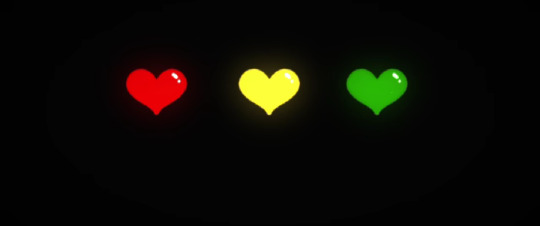



And here's the video I edited:
Interestingly, the clock is moving counterclockwise!
(this has taken so many tries to upload, Tumblr + crappy school Internet/low data bars + video = hell)
EDIT! 10:41 AM!
I missed this in my original analysis, BUT LOOK AT THIS!! Evo symbol!

121 notes
·
View notes
Text
Which F1 fanbase is the fruitiest?
The results!!! The analysis is pretty lengthy, so all the details and the complete analysis as well as the rankings will be under the “keep reading” line for usability of tumblr 😵💫. However, if you don’t want to get into that and are just interested in the main result, know that the most queer fandom amounted to be Liam with 87.5%, and the least Lando with 62.9%.
First off, small mistake on my part that I wanted to address. Whilst making the polls I added aromanticism to the list of sexual orientations 😔. Idk aroace has somehow merged into a single entity in my mind so including both was like a reflex to my tired self, but obviously people can desire to have a sexual life without necessarily wanting to entertain a romantic life! For this reason the aromantic section of the polls will be included to the Prefers not to say/See results section, which means it will not be weighted for the complete analysis. If you still were curious of which fandom contains the highest and lowest rates of aromanticism (normalized dataset by excluding Prefers not to say/See results category), they are respectively Liam with 9.2% and Lewis with 1.2%.
Second off, this research is definitely not meant to be taken seriously! The sample sizes are way too small to be considered representative, and even then Tumblr (sole place where the polls were conducted) has a specific community that may (let’s be honest pretty assuredly lol) present a higher rate of queer representation than, let’s say, Twitter or Instagram. On average only a small fraction of a driver’s fans is present on Tumblr and would have seen the poll I posted, so the proportion of certain sexual orientation (I presume heterosexuality specifically considering the geopolitical environment of formula 1) will be much more significant in real life than shown here. Also, results may have been influenced lightly by people reading the tags from other voters before voting themselves, or even voting on polls for drivers they’re not a fan of instead of using the “see results” option to satisfy their curiosity. That said, the measures here are only meant to be a fun project now that I’m on break 😈.
Time for the interesting part, here come the results!
Starting with a table to compile the overall votes from each fanbase. If you want to explore the polls directly you can check the “Fruitiest f1 fanbase data” tag on Tumblr. The numbers are all x/100 with one decimal due to Tumblr’s limitations.

The main category in most of these polls ended up being the Prefers not to say/See results category, sometimes amounting to more than half of the votes for certain fanbases. As to make the data more interesting to analyze, this category and the aromantic votes (which do not constitute a sexual orientation as specified earlier) will be excluded from further analysis. The values of the relevant votes will be multiplied to come back onto a x/100 basis, to facilitate comparison between fanbases.
Which gives us this more representative graph of the proportion of each sexual orientation in each fanbase by normalizing the proportion of each sexual orientation to the total amount of votes considered for further analysis.

As you can see bisexuality occupies a huge fraction of the votes for all fandoms! Heterosexuality and asexuality are also proudly represented. Gay is surprisingly low in most cases, going as far as being null in Carlos’ fanbase.
As the main goal of this study, overall queerness of the fanbases will be measured first. Here is a ranking of the fanbases from biggest to smallest proportion of queer members out of a hundred people (so total amount of normalized votes minus heterosexuality) :

Liam’s fanbase comes out on top! Obviously the overall queerness representation appears to be wildly over inflated, considering that heterosexuality remains the most common sexual orientation in the world and that Tumblr harbours a pretty specific community. However, considering all data for all drivers’ fanbases was taken from tumblr, the comparison between each other still remains somewhat relevant. Considering the popularity of Carlando on the f1 scene, seeing both their fanbases at the bottom came as a surprise to me.
Next, I made mean averages of the proportion of each sexual orientation in the fanbases (excluding the Aromantic/Prefers not to say/See results categories from the dataset) and compared each fanbase to this average to show who deviated the most from the overall trend.
Thus, this would correspond to the average f1 driver’s fanbase if it was composed of 100 people :

Without surprise, bisexuality keeps its lead over every other sexual orientation. However, seeing heterosexuality as only half of bisexuality’s value feels shockingly low. Others is the least represented category overall, which was to be expected due to its abstract title and low representation irl of sexual orientations different than the ones already named. Gay, as said previously, is the least represented of the named categories.
And here are the deviations for each drivers’ fanbase to the mean average f1 driver’s fanbase in table and graph forms :






The deviations from the mean were also calculated in percentages, but since small variations in the “others” category so drastically affected the percentages and overall scale of the graphs (made other numbers too difficult to see) I preferred not to present the graphs for these results. However, I did make a table to regroup them :

I also performed chi-squared tests to make sure the variations in expected values of the mean average vs observed values in a driver’s fanbase numbers couldn’t be reasonably attributed to hazard and that there was, to a certain degree, a correlation between a driver’s abnormally small or large representation of the sexual orientations compared to the mean. 0.05 was used as the significance level threshold. Cases in green in the subsequent table were over the critical value for the degree of freedom (n=6) and thus permitted the rejection of the null hypothesis :

Based on this table, Lewis could be considered to have the fanbase the most likely to conform to the null hypothesis, and Lando the least likely (null hypothesis=variations due solely to hazard)! Most fanbases fall under the null hypothesis.
Here are the rankings for each specific sexual orientation’s proportion of the fanbase for each driver, from highest to lowest proportion of x/100 :







Notably, Carlando dominates the hetero category, the gays love Mercedes, the asexuals prefer the younger drivers and Liam has the biggest unknown queer community.
If you’re still reading this, well, thanks for taking the time to look at my silly numbers. Hope you have a great day, do crimes, and hydrate! Peace 😪
#f1#formula 1#max verstappen#yuki tsunoda#charles leclerc#lewis hamilton#lando norris#oscar piastri#george russell#kimi antonelli#fernando alonso#lance stroll#carlos sainz#alex albon#pierre gasly#franco colapinto#esteban ocon#ollie bearman#nico hulkenberg#gabriel bortoleto#liam lawson#isack hadjar#carlando#Fruitiest f1 fanbase data
88 notes
·
View notes
Text
Rachel Janfaza at Politico:
New data out of Yale’s Youth Poll broke the internet last week when it revealed a partisan split within Gen Z. Given a generic Democrat vs. Republican ballot for 2026, respondents ages 18-21 supported Republicans by nearly 12 points, while those ages 22-29 backed Democrats by about 6 points. It was a stunning gap that undermined the longstanding notion of younger voters always trending more liberal. On the contrary, today’s youngest eligible voters are more conservative than their older counterparts: According to the poll, they are less likely to support transgender athletes participating in sports, less likely to support sending aid to Ukraine and more likely to approve of President Donald Trump. Fifty-one percent of younger Gen Zers view him favorably, compared to 46 percent of older Gen Z. That split might seem surprising, but it’s only the latest example of an emerging dynamic I’ve noticed developing over the last few years: It’s increasingly clear that there are actually two different Gen Z’s, each with a particular political worldview.
Since just after the 2022 midterm elections, I’ve held listening sessions — open-forums for discussion — with teens and young adults across the country to find out how young people think and feel about politics. I’ve traveled to high school and college campuses, community centers and even homes. And as I’ve written before, these conversations with young people illuminated the distinctions between Gen Z 1.0 and Gen Z 2.0.

Gen Z 1.0, the older segment, graduated high school and tasted independence prior to the start of the Covid-19 pandemic. Their coming of age coincided with Trump’s first term in office and the rise of anti-Trump resistance movements for racial justice and gender equity. Social media apps like Instagram and Snapchat, with all their filters and made-for-social media aesthetics, were commonplace — but TikTok wasn’t yet the massively popular platform it is today. Fast forward to 2020 through today, and those in Gen Z 2.0 came of age under different circumstances. They graduated high school during or after the start of the pandemic, which disrupted their K-12 experience. When many in this cohort began college, it was largely on Zoom, or in a campus environment that barely resembled pre-pandemic times. The political situation was also starkly different: With President Joe Biden in office, Trump and his MAGA movement felt like the counterculture — especially for young men, who swung hard to the right.
Indeed, gender played a prominent role in shaping the youth vote in 2024. An analysis by Blue Rose Research found a 20-point gender gap in Democratic support between men and women ages 25 and younger — the largest such gender gap in any generation by far. “It’s normal to see women supporting Democratic candidates at like a five- to 10-point higher rate than men do,” said Ali Mortell, Blue Rose’s research director. “Among the youngest cohort of Gen Z, it’s north of 20 points. So this is really jarring, and I think, caught the Democratic Party somewhat flat-footed.”
That gender gap has attracted a lot of media attention, but the headlines gloss over some important nuances. While young men turbo-charged Trump’s success in November, they’re not the only Gen Zers shifting right. Despite the overall gender gap, the Yale poll found that, while women ages 22-29 have a net-negative favorability of Trump, those ages 18-21 are more supportive of him, roughly split between a favorable and unfavorable view of the president. Young white women in particular are trending more conservative. Data from Tufts University’s Center for Information & Research on Civic Learning and Engagement (CIRCLE) shows that, while women of color ages 18-29 overwhelmingly supported former Vice President Kamala Harris, young white women were split between Harris and Trump, 49 percent to 49 percent. That’s a huge jump from 2020, when, according to CIRCLE’s data, young white women voted for President Joe Biden over Trump by a 15-point margin.
That could be in part because some of the most formative experiences separating Gen Z 1.0 and 2.0 cut across gender — the most obvious being the pandemic. “We’ve definitely been cognizant that there feels like there’s a change between the kids who got through high school before and after Covid,” said Jack Dozier, the 19-year-old deputy director of the Yale survey. “There is a huge variation that came up between just the college-age young adults, and then the young adults who are over 22.”
In my own research, I started to hear about Covid’s impact in conversations with young Americans in 2022. Throughout history, young people haven’t liked being told what to do, and for many younger Gen Zers, the pandemic restrictions chafed against their youthful discomfort with authority. At first, they expressed annoyance with what they saw as prolonged social distancing on campuses that impacted the student experience. As one 20-year-old told me in a listening session at the end of March: “The adults don’t have it all together, and they don’t have my back.” When students finally went back to school, they complained about the policing of their behavior — not just regarding Covid protections like social distancing and masking, but also broader issues around language. Our national online discourse, these young people said, had adopted an overt political correctness and cancel culture – the tendency, particularly in online spaces, to denounce others for controversial statements or action. Many young people perceived this as promoted by Democrats — those in control, not just in D.C., but in pop-culture and on social media.
[...] “Young people are not only consuming digital media content, non-traditional sources at much higher rates than older generations, but they’re increasingly getting their news from non-political, non-traditional sources,” Mortell told me. But she took it one step farther: “We are seeing this very clear relationship between defection away from the Democratic Party and TikTok consumption.” The rapid onset of TikTok encapsulates the head-spinning pace of change younger Gen Zers have experienced. There are cleavages within every generation, but perhaps none more so than Gen Z, which has grown up amid the fastest speed of technological and political change in recent memory. When it comes to their politics, time will tell if the rightward shift sticks. Until then, anyone trying to understand this generation’s politics will need to figure out just which Gen Z they’re asking about.
The Yale Youth Poll confirms that there are two Gen Z’s, with the older Gen Z cohort tracking more liberal, and the younger Gen Z cohort, especially young Gen Z men, trending conservative.
We’ll see how this will hold up in a few years.
49 notes
·
View notes
Text
Evidence of a powerful link between smartphones, social media and depression, anxiety and self-harm among teenagers, especially girls, is growing, with new Australian research naming 2012 as the year that ushered in a mental health crisis.
The study of longitudinal data found there is a strong correlation between when an individual was born, how old they were when Instagram and Snapchat came into their lives, and self-reported mental health distress and social isolation.
“Young women born since the late 1990s report much lower levels of mental health than earlier generations and compared to their male counterparts,” the analysis from independent think tank e61 says.
“This generation has lived their teenage years when photo- and video-sharing social media platforms became popular in Australia.
“We also find that lower mental health is highly correlated to self-reported feelings of social isolation as measured through friendship connections.”
The analysis was submitted as evidence to a parliamentary inquiry into mental health and social media and whether age limits should be imposed on young people being able to access such platforms, among other things.
The analysis shows that self-reported scores on young women’s mental health declined from 73 per cent to 62 per cent between 2011 and 2022, while for young men it fell from 74.5 per cent to 67.5 per cent.
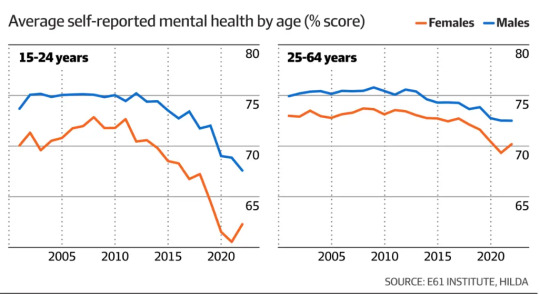
“Youth mental health was stable but then began falling sharply after 2012,” said Gianni La Cava, e61 research director.
Women aged 15 to 24 are the heaviest users of social media. Nearly 90 per cent of them use social media every day, or most days, compared with 62 per cent of women aged over 25.
There has also been a corresponding decline in friendships and feelings of isolation.
The e61 analysis notes some experts argue that social media can be a source of good for some young people, and mental health responses are individualised.
It also notes that there have been vast reductions in the stigmatisation of mental health issues among young people, which means that more may be comfortable in reporting it.
However, e61 says this “would not explain a sudden drop since the 2010s”.
In South Australia, former High Court judge Robert French was tasked in May with examining the legal consequences of banning children under the age of 14 from having social media accounts. The model would also require teenagers aged 14 and 15 have parental consent to access social media platforms.
In March, the US state of Florida legislated to ban social media accounts for children under 14, while Texas has legislated to require parental consent before allowing a user under the age of 18 to open an account. Spain also bans children under 14 from accessing a social network.
A growing body of evidence is linking social media and mental health. A survey by mental health service ReachOut this year found that 60 per cent of parents said they were concerned about their child’s use of social media and 55 per cent agreed that social media had a significant impact on their child’s wellbeing.
A US study found that adolescents who spend more than three hours a day on social media face double the risk of experiencing poor mental health outcomes.
Support services:
Lifeline on 13 11 14
Beyond Blue 1300 22 4636
Kids Helpline 1800 55 1800
220 notes
·
View notes
Text
The Käärijä Research Paper (tm)
aka: Error Analysis of the Use of English Articles in Jere Pöyhönen Interviews in 2023
(Before we start, a couple of clarifications: firstly, I am a linguistics student and this research was my final project for my psycholinguistics course, secondly, this was a group research and I have gotten permission from my friends to share these results with y'all so tysm to them, and lastly, the og work is LONG, 50 pages long, so I'm condensing it into the important bits)
Findings and explanations under the cut <3
Before sharing the actual research, i'm going to share some important terms for you guys to understand the overall layout of this work.
Error analysis: kind of self explanatory, it's the process of analyzing errors, specifically in one's speech, more on how we did this later.
Omission: The alienation of a linguistic form in speech (i.e. I go to (the) supermarket.).
Addition: The opposite of omission, putting an unnecessary linguistic form in a sentence (i.e. It's the maybe half and half.).
Substitution: Exchanging a linguistic form for another one (i.e. He admitted to have stolen a wallet. Instead of: He admitted to having stolen a wallet.).
Overgeneralization: Looking at a grammatical rule and thinking it applies to every case with no exceptions (i.e. finding out verbs conjugated in the past end in -ed and creating conjugations like writted instead of written). Also known as intralingual transfer.
Negative transfer: When your mother tongue (L1) seeps into your second/foreign language (L2) (in this case it's foreign language, but I'll still call it an L2 for simplicity's sake), if we're talking about Spanish negative transfer it can look like: the car red (Spanish adjectives go after the noun, unlike in English). Also known as interlingual transfer.
Local error: An error that does not affect the overall meaning of the sentence, making it still understandable.
Global error: An error that affects the overall meaning of the sentence, making it difficult to understand without clarifications.
Okay, with that out of the way, let me explain what we did:
We decided to make an error analysis on how Jere utilized articles (the, a/an) throughout 2023, for this we considered 2 interviews and 1 Instagram live, the interviews were: KÄÄRIJÄ TRIES LITHUANIAN FOOD (uploaded on 12/04/23) and Episode 3: Käärijä and friends (uploaded on 26/12/23), the ig live was the one he did to promote the release of Huhhahhei on 19/10/23, the dates are important for later.
Now, to do the error analysis in itself we followed Rod Ellis’ proposal for error analysis which follows four main steps:
Identifying errors: Self-explanatory, you see what errors one has committed.
Describing errors: Once you see the errors, you describe what exactly the error is, it can be with grammatical categories, or with omission, misinformation, addition, misordering, and substitution.
Explaining errors: After describing the error you need to explain why this error was committed, the two main ways are through overgeneralization and negative transfer.
Error evaluation: After all this, you identify how the error affected the overall message of the sentence being spoken, was it local or global?
We put these steps into a chart and listened to the interviews and identified the errors we found, it’s a really long chart, so if you want to see it fully you can find it here (hopefully). After identifying all the errors and doing our own error analysis we… well, analyzed the data, duh, according to the objectives we set up for the research.
Our first objective was to identify errors Jere has committed regarding articles in the three videos I mentioned. What we analyzed was more grammatical, so what grammatical structure he used the most. He usually omits an article before a noun and with adjectives, like in: “We go to bar with my producer…”, or “Käärijä goes to boat.”, or “I am fine, uh… little bit tired.”. Obviously, this is kind of expected because Finnish does not have articles, but he also adds articles when it is not necessary, like in: “I have the one festival.” Here are the charts of the grammatical trends:
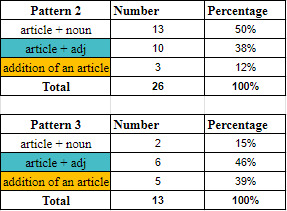

Then we focused on the describing errors part of our analysis. In this part, we found out that he usually finds himself committing omission errors, with 67 in total across the three videos, like I said before, expected, however, the second most common error is addition, this means he adds an unnecessary article in a sentence, and what’s interesting is that he usually does it with the article “the”. Since this is not an actual academic article I will speculate with a full chest: I think he does this because people are usually taught that “the” is the only article in English (only definite one, but not the only one), and that nouns usually have an article accompanying them, so I think that he adds the when he is unsure if an article needs to go there or not. Finally, there was only one case of substitution: “This is the lovely story.”, not really sure why he did this, but it’s interesting that it only happened once. Have the charts and graphs:
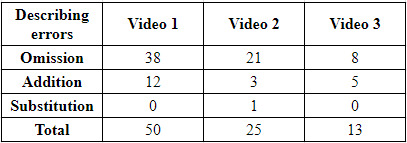
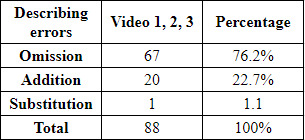
We moved to the next step: explaining errors. When we started this research, we thought that we would only have negative transfers since, ya know, Finnish grammar and all, and we were kind of right? He has committed negative transfer errors the most, with 66 in total, but he also had 23 overgeneralization errors, which I didn’t really expect to happen with articles that much. Not much else to say here, have charts:

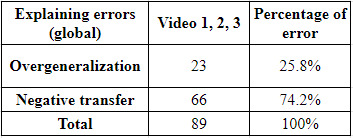
Lastly, error evaluation. He made mostly local errors, which is what mainly characterizes his speech, we know what he’s saying, he just usually lacks some grammatical form that doesn’t affect his overall meaning. He did have 15 global errors that unless you have the context, it can be a little confusing to understand what he’s trying to say (like in the ig live he said “here tour” when he wanted to say “here in the tour”). Charts!

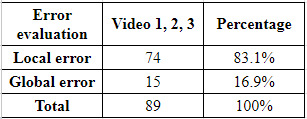
Our final objective was to see the evolution of these errors, has he made more or less as time went on? Well, since we all can see and hear, he has made a great improvement! You already have the charts above to understand that, but I just have to explain it. In the first interview, in April, he made 50 mistakes in total, by the ig live he had cut those in half, and by the latest interview he gave in English he had cut the mistakes in half again! Have the graphs to accurately see this:
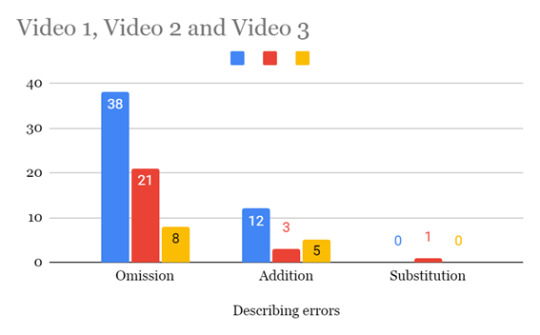
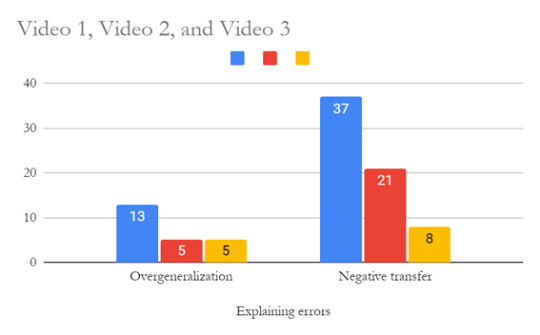

He has improved so much in such a short amount of time! Even more impressive when he hasn’t really taken any formal English classes, just by talking to Bojan and Alessandra. There’s a difference between language learning and language acquisition that was proposed by Stephen Krashen (cool dude, if you’re interested in language learning, go check him out). He says that people usually learn more by acquiring (unconscious) rather than learning (conscious), and you can see that Jere has learnt so much by acquiring English through his friends and his own experiences! And this is just looking at how he uses articles, there is also a distinctive change in how he uses other grammatical forms (but that was too much work for just 2 weeks, maybe I’ll do it later, no promises on anything, though). Even if we’re not talking about his grammatical and syntactical forms, his pronunciation has improved as well! My friends were fascinated by how his accent seemed to develop from video to video, which was very sweet because his accent is one of my favorite things about his speech, but that’s off topic.
The general takeaway from this research is: Jere still has a lot of Finnish tendencies in his English, he has developed his own grammatical structures to communicate in English, and how much he improved in an 8-month period is kind of insane, especially for an adult (who are the age group who have the most trouble learning languages). He’s the it-girl of blowing off a linguist’s mind (me, I’m the linguist)
That would be all!! If you have any other questions, feel free to ask! I'm more than glad to answer them
#hope you enjoy reading this!!#anyways i was supposed to work on my slides to present this to the class tomorrow but...oh well#priorities#i also hope this made sense lmao#käärijä
199 notes
·
View notes
Text
Separately, the DOJ accused two Russian employees of RT, the Russian state-owned media outlet, of a nearly $10 million scheme to create and distribute content to U.S. audiences while keeping the connection to Russia hidden.
RT worked with an online content creation company in Tennessee, which was directed to contract with U.S. social media influencers to distribute its content on social media platforms including, TikTok, X, Instagram and YouTube. Since November, the company posted more than 2,000 videos that received more than 16 million views on YouTube, according to the indictment.
United States intelligence and security officials have been warning for months about Russia’s efforts to interfere in the 2024 election, specifically to undermine the Democratic presidential nominee, exploit social divisions, sow distrust in democratic institutions and to erode support for Ukraine.
The U.S. has provided arms to Ukraine to support its war following Russia's invasion in 2022.
“Russia remains the most active foreign threat to our elections,” Director of National Intelligence Avril Haines told senators in May at a briefing about election risks.
This is not the first time the U.S. has taken action against those behind the Doppelganger influence campaign.
In March, the U.S. Treasury sanctioned Social Design Agency and Structura, as well as their founders, for a network of fake accounts and phony news websites, saying they carried out the campaign "at the direction of the Russian Presidential Administration."
A report released on Tuesday by social network analysis company Graphika documents a cross-platform influence operation linked to the Chinese government with the aim of influencing online discourse ahead of the November 5 elections.
The operation has relied on "spamouflage" to spread misleading or false information, adopting faux American accounts to sow division through anti-government narratives and posts on divisive topics such as the Israel-Hamas conflict, gun control, and racial inequality.
Using ATLAS, its proprietary platform for real-time intelligence and data analysis, Graphika identified 15 such accounts on X (formerly Twitter) and one on TikTok. Mimicking both U.S. nationals and advocacy groups, these accounts have taken aim at both major political parties and called into question the legitimacy of the U.S. electoral process.
They exhibited certain patterns, including the use of U.S.-related hashtags like #American, and presented themselves as U.S. voters who "love America" but feel alienated by issues ranging from abortion to U.S. support for the war in Ukraine.
One X post from June 2023 stated: "Although I am an American, I am extremely opposed to NATO and the behavior of the U.S. government in war. I think soldiers should protect their own country's people and territory from being violated, and should not initiate wars on their own initiative." The post was accompanied by an image depicting NATO's expansion in Europe.
Not to say "I told you so" but I've been saying this for months. Social engineers are hard at work trying to influence the outcome of the election in November. It is very likely happening on a larger scale than we know of. Take everything you read online with a grain of salt between now and November.
#politics#us politics#it's the 'internet research agency' all over again#news#us news#2024 election#op
38 notes
·
View notes
Note
This is prompted by your most recent substack about fame, because my point is extremely tangential, I'm putting it here.
It's interesting to have seen the internet go through many stages. From the newsgroups/BBS era, to internet forums, to blogs, to social media, and how the respective environments shaped things.
In the early days, it's very much a group thing, some people became Big Name posters, pseudonymous, but still a group thing. The blog era was more personal, but still something made by someone who's just a person, even if not literally pseudonymous. Also, still text based, a lot of it even often. Social media changed that, with it's focus on follower counts on one hand and to snippets of text (twitter) or images (insta), and even though it's social media-ness is debatable, video (insta, youtube). The semi-anonymous nature however, was completely lost by now.
The doing it because you enjoyed it, or whatever, also recedes into the background because this is where monetization really takes off. The deleterious effects of the interaction between monetization and follower counts (notability) need no introduction, but painting with broad strokes, make something appeal as broad as possible deepens the flattening effect a medium like video already has, the visual aspects often being more important than the messages. It also has a much higher barrier to entry. Spinning up your own blog is cheap, text takes only a tiny amount data. Video is not. It's expensive to make (especially if you want slick videos), expensive to serve, so it's predisposed to big, single platforms that can leverage economies of scale.
The natural result is that you have a few people with big audiences, instead of many people with small audiences. If audiences is even the right word for that. If I'm talking about say, some TV show on my blog, and someone responds, it's a fairly equal conversation. More between peers, of sorts, just two people talking about something they share. As opposed to a Youtuber who makes a video about it with 100,000s of viewers. Because there are so many fewer voices, you lose the breadth of conversation too, narrowing to a small range of popular topics, and the distinction between You, and You as Your Brand gets eroded.
It's kinda notable in the autism sphere. Blogs where people talk about their experiences, how they dealt or didn't deal with things, have fallen off. Twitter came and went, and now there's Youtube and insta, where everything gets simplified down to a few slides or a 10 minute video about only the most basic aspects. Which is just... sad. I wouldn't have known that autistic burnout is a Thing many people struggle with if not for a blog post a friend came across and shared one day.
There was a comment from someone, a while ago, about how they used to have ASMR videos on, until they were able to get out into nature, and their desire for those videos completely disappeared. We're all very deprived. Of social contact, foremost. The pandemic poured gasoline on an already smoldering fire I feel. Latching onto someone 'famous' in a surrogate of social contact & context, like that person with their ASMR videos, feels like an understandable (though not good) outcome of that, which brings with it very regrettable excesses.
I think this is all pretty much a correct analysis, thank you! Though I would qualify that we have shifted away from the period of the Youtube mega content creator a social media ecosystem of intimate-seeming connections with smaller influencers, these days. Think of your Twitch streamers with a dedicated base of like 50-200 viewers per stream (and a Discord and a Patreon that supports them), the fitness Instagrams that sell meal plans online, the tarot witches and activist influencers offering one on one sessions, etc. Those communities can be more niche, but they still offer the illusion of a connection -- and if anything, that illusion is more strong because the creator is a "micro" famous person, and can take time to interact closely with fans here and there. We might already be heading out of that period of social media, though, especially with the disintegration of Twitter and the slow death of Meta's apps, too. I don't know what comes next but I hope we are due for a reappraisal of all of this, and the norms surrounding it.
27 notes
·
View notes
Text
President Trump and his former star advisor, Elon Musk, have accelerated the deployment of a vast technological infrastructure that monitors the lives of millions of people. The system is focusing on immigrants — for now Massive unauthorized scanning of social media. Analysis of biometric, income, health, and Social Security data. Interception of telephone communications. Geolocation via mobile devices. Tracking of car journeys using license plate readers. Since Donald Trump returned to the White House, the U.S. government has been using these and other tools based on artificial intelligence (AI) to monitor and persecute thousands of people without judicial authorization — mostly immigrants, foreigners passing through, or students. In the last four months, Trump and his former star advisor, the tech tycoon Elon Musk, have, along with the private sector, accelerated the deployment of a massive techno-surveillance state. And for the first time in history, Washington is boasting about it rather than denying its existence. “Surveillance in the U.S. didn’t begin with Trump, nor will it end when he leaves the White House. The foundations for the current state of techno-surveillance were laid over decades, with bipartisan support for policies that normalized invasive practices in law enforcement, the military, and border control,” says the Bahraini civil rights activist Esra’a Al Shafei, who has been studying this issue for years, in a conversation with EL PAÍS. “This system is fueled by large budgets allocated to intelligence agencies, as well as private providers, all under the pretext of national security and crime prevention.” Companies like Palantir, Anduril, and GEO Group are providing Washington with digital tools to build this entire surveillance infrastructure. Trump continues to add layers to this system. The Department of Homeland Security (DHS) confirmed in April that it is using a tool called Babel X to collect social media information about travelers who may be subject to increased surveillance, according to the agency itself. Immigration and Customs Enforcement (ICE), for its part, has acknowledged using another program, SocialNet, which aggregates data from more than 200 sources, including Facebook, Twitter/X, Instagram, LinkedIn, and dating apps.
continue reading
6 notes
·
View notes